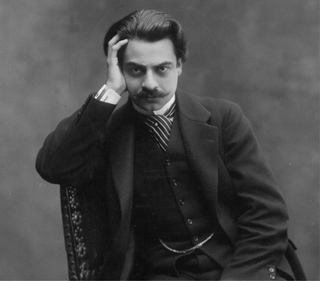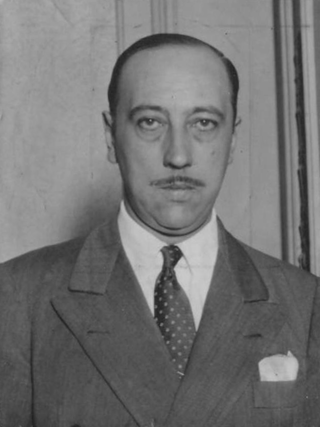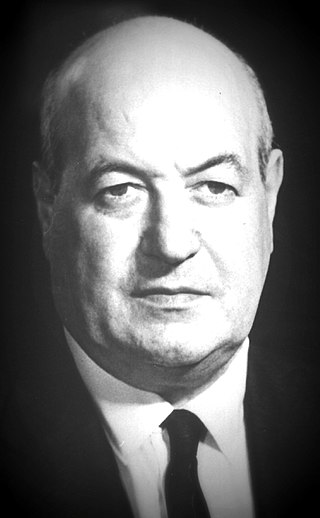The Conservatorio Nacional Superior de Música is the national music conservatory for Argentina and it is located in Buenos Aires.

Raúl Scalabrini Ortiz was an Argentine writer, philosopher, journalist, essayist and poet, friend of Arturo Jauretche and Homero Manzi, and loosely associated with the political group Fuerza de Orientación Radical de la Joven Argentina (FORJA).

Paul-François Groussac was a French-born Argentine writer, literary critic, historian, and librarian.

The Spanish settlement Nueva Colonia y Fuerte de Floridablanca was established in San Julian Bay in 1780 and abandoned four years later due to scurvy. The settlement was deliberately destroyed so the facilities could not be used by foreign powers.

Villa Lugano is a barrio (neighbourhood) in Buenos Aires, Argentina, located in the south of the city. It has a population of approximately 114,000 people. It is delimited by Avenida Eva Perón, Avenida General Paz, Calle José Barros Pazos, Avenida Lisandro de la Torre, Avenida Coronel Roca and Avenida Escalada. To the south-east it limits with La Matanza Partido.

Ricardo Ernesto Montes i Bradley, poet, essayist, art historian, and literary critic and diplomat born on June 9, 1905, in Rosario, Argentina. He was Honorary Consul of México in Rosario, professor of Fine Arts, publisher, columnist and contributor in newspapers and literary magazines in Latin America. R-E Montes i Bradley held Doctorates in the Law, Diplomacy, History and International Law. He was an active member of the International Institute of Ibero-American Literature and the International Association of Critics; Correspondent Member of the National Academy of Arts and Literature of Cuba and of the National Academy of History and Geography of Mexico; Honorary Member of the Mexican Academy of Genealogy and Heraldry ; member of the Sociedad Argentina de Escritores (SADE); a member of the Círculo de la Prensa and the Colegio de Abogados de la Ciudad de Rosario; co-founded the Escuela de Bellas Artes de Rosario; member of the Asociación de Críticos de México. As publisher, he was responsible for the Boletín de Cultura Intelectual, which he also directed; the art magazines Revista Paraná and Cuadernos del Litoral were also the result of his commitment to journalism in the arts. The last two publications were dedicated to promote the works of local artist, writers, poets in the region known as Paraná, Rosario de Santa Fe and vicinity.

Ricardo Rojas was an Argentine journalist and writer. He came from one of the most influential families of the Santiago del Estero Province; his father was Absalón Rojas, who was governor of the province. He moved to Buenos Aires to further his education, later becoming rector of the University of Buenos Aires from 1926 to 1930. He was also the director of the Institute of Petroleum.

Ernesto Palacio was an Argentine historian and part of a generation of right-wing nationalist intellectuals active from the 1920s. Their ideology is referred to as nacionalismo.
Saturnino Canaveri was an Argentine military man and politician, who served as officer of the 2nd Cavalry Regiment. He took part in the main military actions that occurred during the Conquest of the Desert, including the actions prior to the Battle of Aluminé, against the Chilean Army.
Rodolfo Motta was an Argentine football player and coach.

Tomás Onésimo Canavery (1839–1913) was an Argentine Catholic priest and military chaplain, who served under the command of Bartolomé Mitre during the War of the Triple Alliance. He participated in most of the military actions against the Paraguayan forces, being promoted to lieutenant colonel in the same battlefield by order of General Juan Andrés Gelly y Obes.

Elina González Acha de Correa Morales was an Argentine educator, scientist and women's rights activist. In her early days, she was among the first graduates of the Argentine Normal School and was a painter, winning international recognition for both her textbooks and paintings. She was the driving force behind the founding of the Geographical Society of Argentina and served as its president from its establishment until her death. She and her husband, Argentina's first renowned sculptor, Lucio Correa Morales were defenders of the land claims of the Ona indigenous people.

Francisco Álvarez Campana (1707–1773) was a Spanish merchant and politician, who served during the Viceroyalty of Peru as Regidor and Attorney General of Buenos Aires. He was the founder of the Colegio de Huérfanas de Buenos Aires, an educational institute dedicated to the teaching of orphan girls.

José Babini was an Argentine mathematician, engineer, and historian of mathematics and mathematical sciences.
ARA Luisito (Q-51) is a training ship of the Argentine Navy, in service since 1985 and based in Mar del Plata; where she is used to train students from Argentina’s National Fishing School. The vessel is the first Argentine naval ship with this name.

María Seoane was an Argentine economist, journalist, and writer who ventured into film. She won numerous awards and published eight books on political issues in Argentine history. She was the director of LRA Radio Nacional from 2009 until her resignation on 21 December 2015. Seoane died on 27 December 2023, at the age of 75.

Andrea Graciela Giunta is an Argentine art historian, professor, researcher, and curator.

Alberto Luis Rocamora was an Argentine politician. A member of the Justicialist Party, he was an early supporter of President Juan Perón and his entire career unfolded as a member of the Peronist Movement.

Roberto Levillier was an Argentine historian and diplomat.

Humberto Francisco Burzio was an Argentine naval historian, numismatist, military officer and one time ambassador to Peru.














